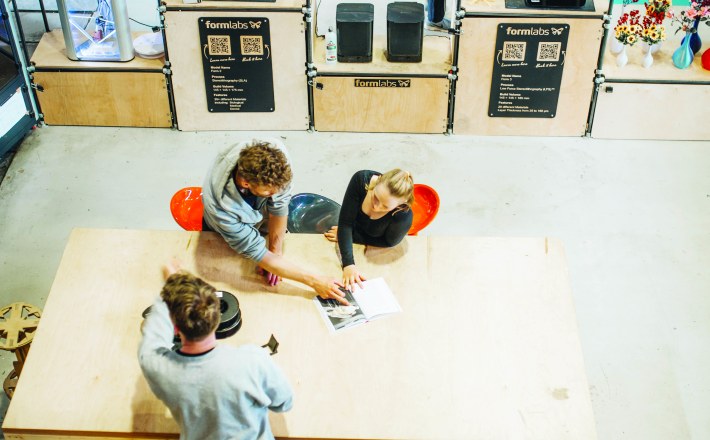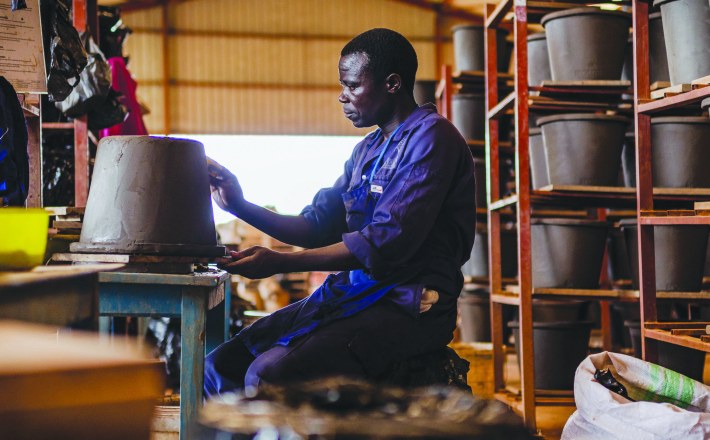South Africa’s Hidden Gems
Sustainable tourism is developing in the South African province of KwaZulu-Natal. With organisers such as WOWZULU, an NGO which has made it its goal to strengthen rural, marginalised communities, the region can be experienced off the beaten track—for example on a trip to Inanda, where COMPANION learned about traditional Zulu beadworking from Mma Mtshali.
The midday sun shines brightly on the small village nestled between the bustling township of Inanda and the rural Mzinyati, about half an hour outside Durban, South Africa’s third largest city. It is August, in the depths of winter, but today it is warm enough for an airy skirt and T-shirt. This is how Mma Mtshali stands in front of her turquoise house, radiant as she waits for her guests to climb up the steep hilly path towards her. ‘Sawubona,’ she shouts from afar: ‘I see you’—the poetic ‘hello’ of the Zulu, who make up South Africa’s largest ethnic group with a population of around 10-12 million people, most of whom live here in the province of KwaZulu-Natal.
‘KwaZulu’ means ‘the place of the Zulus.’ This is where Mma Mtshali was born, and where she has spent her entire life. Mma Mtshali’s first name is Eunice, but out of respect for the 51-year-old, everyone here only calls her Ma. For more than two years she has been opening the doors to her own four walls for interested visitors, mostly tourists. Actually, it is only one wall: She lives in a traditional round rondawel house that is often seen in Zulu villages and that invites people to sit together chatting in a circle formation. Here, the craftswoman gives courses in beadwork, through which she also shares her culture. On a large mat on the floor, where she now takes a seat and briefly types a message into her smartphone, countless multicolored beads are already waiting for the group to be processed into jewelry.
The arts and crafts have made me proud of my homeland.
Mma Mtshali
Visits to Mma Mtshali’s place are organised by WOWZULU, a sustainable tourism company that’s active in KwaZulu-Natal. They organise off the beaten track tours to rural communities in the area with the aim of supporting marginalised and often poverty-stricken communities. WOWZULU was founded in 2014 as an offshoot of Africa!Ignite, a non-profit rural development agency that has been helping young people and women in the region for over a decade now, focusing on empowering them to own businesses and improve their lives.
Globally, tourism is booming. It is one of the most important and fastest growing economic sectors in the world—at a rate of 3.8 percent annually, the World Tourism Organization estimates. According to the UNWTO, there were 1.3 billion worldwide cross-border arrivals in 2017. Then there is the tourism industry’s dark side: Precarious working conditions, enormous CO2 emissions due to the increasing number of flights and the destruction of nature through conventional mass tourism.
Companies such as WOWZULU show that travel does not necessarily have to be bad. Quite the contrary. Sustainable tourism can promote the flourishing of species and nature conservation and create new income opportunities, which boosts the local economy. This can create new job and training opportunities. This is how Bongiwe Mlangeni, WOWZULU’s Operations Manager, understands her mission: ‘We support communities that are on the doorstep to tourist hotspots, but have not yet benefited from them,’ she says.

KwaZulu-Natal has a lot to offer when it comes to dream tourist destinations. There’s Durban itself, with its warm climate, the relaxed surfer vibe and some of the country’s most beautiful beaches. There are the nearby Drakensberg Mountains, a breathtaking mountain landscape in which the small kingdom of Lesotho is embedded. And the township of Inanda itself, whose brook-filled landscape invites hiking, mountain biking and canoeing. It’s also the cradle of South African democracy: Gandhi lived here for over 20 years. And Nelson Mandela first voted here, in 1994, at the Ohlange Institute, exactly 25 years ago. The end of apartheid.
This historical place, which still today serves as a secondary school, is also the site of one of WOWZULU’s marketplaces, where the products of cooperating local artisans such as Mma Mtshali are sold. This is also the starting point for the tour to her home—for today’s visitors, she has already spread out some particularly pretty testaments to her skills: In addition to fine bracelets, her table also displays impressively large necklaces consisting of several semicircles and belts on which long pearl fringes dangle. All unique pieces and works of art. ‘You don’t usually create something like this in an hour,’ she says, laughing.
For now, she starts with simple bracelets. Mma Mtshali pulls a thread through the small eye of the needle with fast, routine movements, turns a knot into the end and cleverly threads several of the tiny, colorful pearls. What takes her guests a while only takes her a few minutes. Mma Mtshali can create about 100 of these bracelets a day, while for larger, more elaborate pieces she sometimes needs a week. She has practiced this all her life, having learned the art of processing pearls from her mother, who in turn learned the art from her own mother, just like generations before them. Like pottery or basket weaving, the making or decorating of jewellery, clothing and utensils with precious stones and pearls has a centuries-old tradition in the Zulu culture.
Traditionally, Zulu women and men alike are elaborately adorned. Their artistic pearl ornaments are considered some of the most beautiful in the world. In the past, necklaces, belts, loincloth or hats of the traditional tribal costume were made from ivory, shells, eggshells, wood, bones and others. Later, when the trade with amber and other precious stones—in particular, glass beads—began, the pieces of jewellery also became finer and more complex. This is how Zulu jewellery gained its artistic reputation.
It is still the Zulu women who practise the craft of pearls. The stones are often no longer made of glass but rather from plastic—and the jewellery, like the traditional costume of the tribe, is no longer worn daily, but only at special festivals. Like the yellow pleated skirt embroidered with pearls, the Isidwaba, which Mma Mtshali now wears for fun. Previously made from cowhide, itis now made from bright fabric. The bride wears it during a traditional Zulu wedding. Or the Isicholo, the Zulu wedding hat. It looks a bit like an inverted funnel and used to take on dimensions the size of a cartwheel. ‘In the past, the hat was interwoven with the bride’s hair, and remained firmly on her head for months,’ says Mma Mtshali, laughing. ‘But today that’s no longer the norm.’
Mma Mtshali explains that the pearl works not only have a decorative function for the Zulu, but also serve as communication, a non-verbal language full of symbols and hidden codes that provide information about the relationship between the sexes—even if modern means of communication today, as everywhere else in the world, have naturally dampened the importance of these symbols in everyday life. Yet if you take a closer look at Mma Mtshali’s works, you will notice that the triangle in particular appears again and again as a central form. With an upwards point it stands for the woman, the other way around for the man. The merging of two triangles into a diamond, on the other hand, reveals, like a wedding ring, a married woman—and two triangles assembled like an hourglass stand for the married man.
The colours also have their significance. Blue stands for peace, white for purity, green for nature and red—‘naturally for love,’ says Mma Mtshali, chuckling. This is the simplified version. Depending on how colours and shapes are put together, complex statements emerge—the interpretation of which can fill entire books. ‘But you can’t do anything wrong with such simple bracelets,’ says Mma Mtshali. She should know—she certainly has enough experience.
Since 2007, Mma Mtshali has been working with Africa!Ignite and partly with MIET, a sister NGO from which the former stemmed. Meanwhile, she has gathered a whole host of beadworkers around her, whose bracelets, necklaces, decorated dolls and pillows are sold at the WOWZULU marketplaces located in seven destinations across KwaZulu-Natal, as well as internationally: WOWZULU has a growing customer base in the USA, Canada, Australia, Germany, the Netherlands and the United Kingdom among other countries. The courses that Mma Mtshali gives with increasing frequency are especially fun for her. She says: ‘The curiosity of my guests and their enthusiasm for Zulu culture is thrilling. The arts and crafts have made me proud of my homeland.’

It is fitting, then, that intercultural encounter and mutual exchange is one of WOWZULU’s main goals. Bongiwe says: ‘With all our tours, we want the tourists to actually talk with the community instead of viewing locals from the perspective of an observer. We don’t want one-way communication, but rather a dialogue that leaves its mark on everyone’s lives—because the locals are also curious to find out more about visitors’ cultures. The exchange is enriching for everyone.’
The tours offered by WOWZULU and other sustainable tour operators therefore stand in stark contrast to folkloric theme parks, where dancers or amateur actors in costumes perform Zulu culture for tourists in staged shows. They usually have little to do with the realities of contemporary Zulu life—and often not even with the past. Instead of authenticity, the ‘African tribal cliché’ is performed there, which may sadly even strengthen the existing prejudices of tourists.
‘I think the way in which one encounters other cultures also has to do with education,’ says Bongiwe. ‘Many of the people who book tours with us are very enlightened and cosmopolitan and have already travelled a lot’. Of course, travelling opens up horizons. ‘But for many travellers, security is certainly also a decisive factor,’ says Bongiwe. This is a problem in South Africa—caution is required everywhere and at all times. Bongiwe therefore advises against exploring the townships on one’s own. This has to do not only with safety, but also with respect. After all, the tours go into the most intimate spaces, including people’s own homes—and no-one wants unannounced tourists standing outside their doors.
With the sustainable tours, not only beadworkers like Mma Mtshali or other craftspeople profit, but the whole community—on average, 28 people per tour, according to WOWZULU. For example, if you go on a day trip to Inanda, you will eat out, stop off at a café, maybe visit a museum and perhaps undertake an outdoor activity such as a canoe trip. Locals are supported with everything, not least drivers and guides, who also come from the respective regions and, as with the encounter with Mma Mtshali, who speaks little English, often also act as translators. And as bridge-builder between visitors and locals.

With its current offering of seven destinations, WOWZULU directly supports around 200 people, in addition to around 250 craftspeople who produce for them regularly within a network of around 1,000 creatives, the rest of whom sporadically work for the non-profit company. All in all, WOWZULU pursues the values of fair trade. They ensure that people are paid appropriately for their work, and that the money from the tours ends up where it belongs—with the locals in KwaZulu-Natal. According to its own statements, Africa!Ignite was able to generate revenues of around 6 million rand between 2015 and 2018—the equivalent of 370,000 euro.
It is difficult to say what this figure really means—and how great the impact of WOWZULU is on the region—because the number of those who could or should theoretically be supported there cannot be determined. Take the example of the beadworkers: It is impossible to say how many of the crafters live in the province, according to WOWZULU and the South African Beadwork Association. The reason for this is the largely informal way in which the work is carried out: many women do the craft only as a hobby and only occasionally sell something, often simply by the roadside. Others may sell on a part-time basis, but are not registered anywhere. Despite the complexity, nationwide arts and crafts sector market is valued at an estimated 3.6 billion rand—about 220 million euro.
Sustainable tourism can create new income opportunities, which boosts the local economy.
Mma Mtshali
In fact, however, the informal nature of the sector is one of the reasons for its great potential, because it provides direct access to the labour market for women like Mma Mtshali, who learned the craft like everyone else from her mothers and grandmothers. They don’t have to invest money in training because they already have the necessary skills and can do the work flexibly from home in addition to their other activities—in the rural areas of KwaZulu-Natal women still traditionally take care of raising children and the household.
Supporting them makes sense for so many reasons. One extra plus is that according to WOWZULU, one rand in a woman’s hand contributes more to the family’s budget than one in a man’s. Their beadwork is either a supplement to the family income, or often the women are the sole earners.
Take Mma Mtshali: She attended school up to the fourth grade and never had a formal job. In the beginning, her beadwork only added a little to the household budget. When her husband, who had a full-time job, died in 2015, she became the sole breadwinner for her two children, and her husband’s two children, overnight—and meanwhile there are already two grandchildren of whom she takes care. The hardest part was to get the older kids through school, she says. She benefits from the fact that, together with WOWZULU and the expansion of the distribution system, the regularity of her orders is growing and, on top of that, the number of beadwork lessons is increasing.
Mma Mtshali retains around 60-70 percent of the profits per product sold. She can determine their price herself. One of the narrow, colourful bracelets with an iconic triangular pattern costs around 50 rand—three euro. Unlike the much more elaborate, but also more traditional belts or gigantic chains, which might attract collectors more, they’re popular souvenirs. And they’re fashionable. Mma Mtshali has just finished another one and turns it back and forth on her wrist. ‘Looks really chic,’ she says, grinning mischievously. She’s right.




